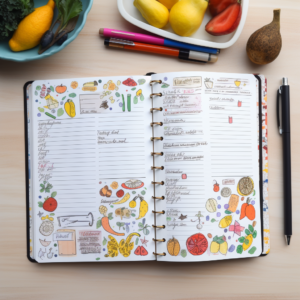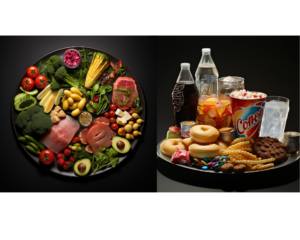
Opportunity + Perseverance = Success
Shop the Perimeter:
Why it’s a secret:
When you enter most grocery stores, you might not immediately realize there’s a strategic layout in place. Fresh produce, lean proteins, dairy, and seafood are generally placed along the store’s perimeter. This isn’t just for aesthetic or logistical reasons—it’s often where the healthiest, freshest options reside. In contrast, the inner aisles are a maze of tempting processed snacks, sugary beverages, and other less wholesome choices.
How to use it:
Next time you’re out grocery shopping, start your journey around the edges. Let the colors of fresh fruits and veggies, the scent of fresh bread, and the chill of the dairy section guide your selections. Once you’ve filled your basket with these nutritious staples, you’ll find less room—and less temptation—to stock up on those not-so-great choices lurking in the middle aisles.
Look High and Low on Shelves:
Why it’s a secret:
Here’s a little inside scoop: Big brands often shell out significant sums to secure those eye-level shelf spots. It’s prime real estate in the grocery world. While some of these products are indeed quality options, many are simply there because of advertising deals, not because they’re the best choice for your health.
How to use it:
On your next shopping trip, you could make a small game out of it. Duck down or tiptoe up, exploring the topmost and bottom shelves. You’ll often discover store brands or lesser-known products that deliver the nutrition and cost you seek. Plus, who knows? You might find a new favorite brand that you’d previously overlooked.
“5 Ingredients or Less” Rule:
Why it’s a secret:
In today’s fast-paced world, the allure of convenience foods is undeniable. But the trade-off for that convenience is often a long list of additives, artificial flavors, and preservatives. A shorter ingredient list can often signify a product that’s closer to its natural state.
How to use it:
Challenge yourself to check the ingredient lists of products before they make it into your cart. Suppose you spot items with five or fewer ingredients, especially those you can recognize and pronounce. In that case, you’re likely on the right track. This simple trick can quickly become second nature and steer you toward healthier choices.
Beware of Buzzwords:
Why it’s a secret:
Food packaging sometimes feels like it’s speaking its own language. Phrases like “all-natural” or “low-fat” can sound healthy and appealing. Still, unfortunately, they don’t always mean the product is beneficial for your diet. Check out our article on reading Food Packaging Labels for specific details.
How to use it:
Turn that package over and read the nutritional profile instead of letting the eye-catching front label influence you. The back label tells the true story with its nutrition facts and ingredient list. Remember, an informed shopper is a healthy shopper.
Plan and List Before You Go:
Why it’s a secret:
Without a roadmap, even the best-intentioned journeys can go awry. The same goes for grocery shopping. Walking into a store without a game plan can lead to a cart full of impulse buys and forgotten essentials.
How to use it:
Prior to entering the store, take some time to plan your weekly meals and make a list of the essential ingredients. This simple act gives you a clear mission and makes you less susceptible to impulse purchases. Bonus: It’s also an excellent strategy for saving money and minimizing food waste at home.
–Be Mindful of Seasonality:
Why it’s a secret:
Nature has its own rhythm, and different fruits and vegetables peak at various times of the year. Not everyone is aware, but seasonal produce doesn’t just taste better; it’s often more nutrient-rich and affordable. Grocery stores and markets stock up on what’s plentiful, meaning that in-season items are often fresher and priced more attractively.
How to use it:
Before you go shopping, quickly check what’s in season in your region. You might even discover some new favorites! When you prioritize buying seasonal produce, you’re treating your taste buds, supporting local farmers, and reducing the environmental impact of long-haul transportation.
Opt for Whole Grains:
Why it’s a secret:
The bread and cereal aisles can be daunting. With so many options, it’s easy to reach for familiar names and packages. However, many of these are made with refined grains, lacking the essential nutrients in their whole-grain counterparts.
How to use it:
Make it a habit to look for the ‘whole grain’ label when shopping for bread, pasta, rice, or cereals. Whole grains, like quinoa, brown rice, and whole wheat bread, have all parts of the grain intact, ensuring you get the maximum nutrients and fiber. These provide better fuel for your body and keep you feeling full longer, reducing the chances of unnecessary snacking.
Limit Sugary Beverages:
Why it’s a secret:
Drinks such as sodas and sugar-laden iced teas significantly contribute to elevated levels of sugar consumption. Although they may appear refreshing, these beverages often contain high sugar and provide little nutritional value. This includes diet sodas as well. Although they are not high in sugar content, they provide little nutritional value. They are filled with artificial sweeteners and other additives that may have a detrimental effect on your health.
How to use it:
Swap out sugary drinks for healthier alternatives. Love carbonation? Opt for sparkling water with a splash of natural fruit juice or a slice of lemon for flavor. If you’re after caffeine, consider unsweetened teas or black coffee. These simple swaps can significantly reduce your daily sugar intake, promoting better health in the long run.
Diversify Your Protein Sources:
Why it’s a secret:
While meat is a go-to protein source for many, there’s a world of protein-packed alternatives that are both nutritious and delicious. From plant-based options like beans and lentils to dairy and seafood, diversifying your protein intake can offer a range of health benefits.
How to use it:
Next time you’re shopping, venture beyond the meat aisle. Explore tofu, tempeh, beans, lentils, and seeds like chia and flax. Incorporating various protein sources ensures a more balanced diet and introduces you to new and delightful meal ideas.
Check the Unit Price:
Why it’s a secret:
Have you ever stood in the aisle, comparing two products, and wondered which was the better deal? The unit price is a valuable tool that many shoppers overlook. It breaks down the cost per unit (like per ounce or gram) and can give insights into which product offers the best value.
How to use it:
Most stores provide the unit price on the shelf label. So, instead of just looking at the total cost, look at the unit price to determine which product is the most economical choice. This ensures you get the most bang for your buck, especially when comparing brands or package sizes.


